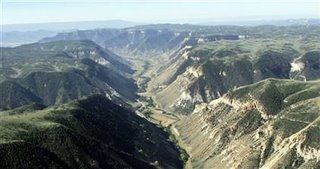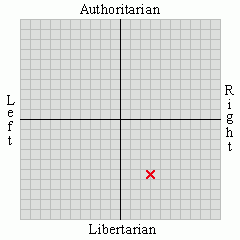 It involves drilling into oil shale, dropping large heating elements into the rock, and extracting petroleum. High-grade light crude and natural gas emerge from the well once a critical temperature is reached. One square mile of oil shale formation will yield a billion barrels of oil -- and in Colorado, there is a formation over a thousand square miles and in total, the U.S. has over sixteen thousand square miles of oil shale within its borders, on land like that illustrated in the picture above.
It involves drilling into oil shale, dropping large heating elements into the rock, and extracting petroleum. High-grade light crude and natural gas emerge from the well once a critical temperature is reached. One square mile of oil shale formation will yield a billion barrels of oil -- and in Colorado, there is a formation over a thousand square miles and in total, the U.S. has over sixteen thousand square miles of oil shale within its borders, on land like that illustrated in the picture above.Today, the President of Mexico announced that the government has located a heretofore-unknown offshore oil bank which is anticipated to yield ten billion barrels of oil and that the fields will begin producing oil in eight to ten years.
 The United States consumes an average of 20.7 million barrels of oil a day, or about 7.56 billion barrels a year. Mexico consumes about 2 million barrels of oil a day, or about 730 million barrels of oil a year. The new find in Mexico is of comparible magnitude to the emerging feasibility of shale oil extraction in the United States -- both countries will be able to become oil exporters even after satisfying domestic demand. Canada is already a net oil exporter -- and its biggest customer is the United States.
The United States consumes an average of 20.7 million barrels of oil a day, or about 7.56 billion barrels a year. Mexico consumes about 2 million barrels of oil a day, or about 730 million barrels of oil a year. The new find in Mexico is of comparible magnitude to the emerging feasibility of shale oil extraction in the United States -- both countries will be able to become oil exporters even after satisfying domestic demand. Canada is already a net oil exporter -- and its biggest customer is the United States.The only other country presently capable of reaching oil exporter status is Russia, which has so far proven unable to master its own economy enough to develop the infrastructure necessary to develop its Siberian oil reserves, and there is less reason to be optimistic about Russia's industrial and economic development than Mexico's.
 The member nations of OPEC are Algeria, Indonesia, Iran, Iraq, Kuwait, Libya, Nigeria, Qatar, Saudi Arabia, the United Arab Emirates and Venezuela. You'll note that about half of these nations are not particularly friendly to the United States. Oil has made them all rich, to be sure, but they are all producing oil at near-capacity levels. OPEC currently controls about 40% of the world oil production, which is a large enough market share that it can effectively control prices. Should the world become awash in North American oil in ten years, though, OPEC's market share would drop to about 15% and the biggest player in the world supply market would be the U.S. -- which would, of course, leave the price of oil largely subject only to market forces.
The member nations of OPEC are Algeria, Indonesia, Iran, Iraq, Kuwait, Libya, Nigeria, Qatar, Saudi Arabia, the United Arab Emirates and Venezuela. You'll note that about half of these nations are not particularly friendly to the United States. Oil has made them all rich, to be sure, but they are all producing oil at near-capacity levels. OPEC currently controls about 40% of the world oil production, which is a large enough market share that it can effectively control prices. Should the world become awash in North American oil in ten years, though, OPEC's market share would drop to about 15% and the biggest player in the world supply market would be the U.S. -- which would, of course, leave the price of oil largely subject only to market forces.So take a moment and consider the vision of an oil-rich world. The three NAFTA nations are all oil exporters, with their biggest customers on the Pacific rim of Asia. Europe gets more of its oil from Russia than OPEC. OPEC's primary customer becomes... India, I guess.
Currently, oil costs about sixty dollars a barrel. Should the Colorado shale and Mexican offshore projects come to fruition, the by the mid-2010's, the price of oil will be driven down to 1980's oil glut levels in real dollars. U.S. consumers could see gasoline costing the equivalent of $1.00 a gallon in 2006 dollars.
 I'm pretty sure this would not be good for the environment. Cheap oil would mean more of it would be consumed. But I'm more interested in geopolitics. Does this make the world a more or a less dangerous place in ten years? What happens to the global alignment of military and economic power? Comments from the Loyal Readership are solicited!
I'm pretty sure this would not be good for the environment. Cheap oil would mean more of it would be consumed. But I'm more interested in geopolitics. Does this make the world a more or a less dangerous place in ten years? What happens to the global alignment of military and economic power? Comments from the Loyal Readership are solicited!







1 comment:
I thought the problem with oil shale was that the resulting oil was considerably more expensive per barrell than oil is currently.
As lefty as this sounds, I have always thought the solution was alternative energy.
Post a Comment